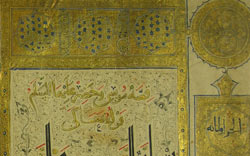Text and Margins
Margins are generally distinguished from the text with thin lines, called borders or jadval. Depending on the fineness of the manuscript or book, it could have multiple margins of varying colors. In fine manuscripts and albums, the paper for the text and the margin are usually of a differing type and color. Sometimes, the text of a book would be written on two pieces of thin paper that were glued together so that there would not be a shadow from the text on the other side of the page. For this reason, the paper used for the margin of the page would often be twice as thick as the paper used for the text. Margins serve a particularly important purpose in works of qur’anic text, where the physical text itself could be handled only in a state of ritual purity. In such cases, wide margins allowed a person to touch the text without physically tainting the purity of the Qur’an’s words.
In this piece, the difference between text styles works to emphasize and distinguish the qur’anic text from the non-qur’anic text. Here, the rarely-used bold, angular script is used for the qur’anic text and highlights its special monumental nature, as though it were inscribed on a building. The non-qur’anic text, by comparison, is written in a lighter, rounded script which accentuates the contrast between the word of God and the word of man.
Symmetry
Symmetry is a common aspect of Islamicate arts, but at times slight varieties are embedded in seemingly symmetrical pieces, either for the sake of variety itself or because differing sizes of letters and words, which are out of the control of the artist, would disrupt the symmetry of the page. As such, despite their symmetrical appearance, there is rarely perfect symmetry in these works.
Tazhib
The art of illuminating manuscripts or the borders of calligraphic works is called tazhib. It is derived from the Arabic word for gold, dhahab, and it usually requires using gold. Tazhib, however, is not exclusively in gold. Other colors such as white, red, azure, etc. are also used. Tazhib drawings, which have a long history, are not naturalistic drawings; rather they are based on the imagination of the artist and are thus regarded as a distinct form of drawing.
Tazhib can be understood as a specific kind of gilding, but there are two ways in which gold was employed in the traditional art of bookmaking in Iran. In one, gold papers, which were extremely thin and brittle were used to cover all or part of the surface of a page. In the other, gold was used in liquid solutions for drawing or for writing, as in the case of tazhib. The following is the traditional method used for making gold solutions. A small piece of gold was placed between two pieces of leather, and hammered for a long time until a very thin layer of gold was produced. Then, the thin layer of gold was ground in a container with gum arabic or another type of adhesive material that produced a gold solution, which was then used as ink for writing, drawing, or creating borders.


